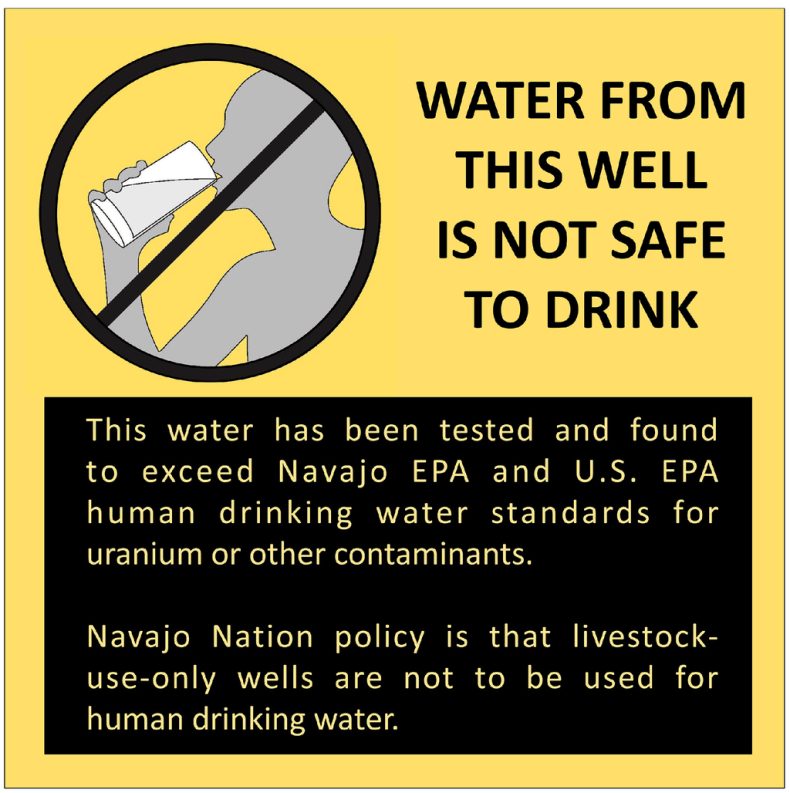
by Deep Green Resistance News Service | Feb 11, 2016 | Colonialism & Conquest, Toxification
Featured image: Figure from EPA Pacific Southwest Region 9 Addressing Uranium Contamination on the Navajo Nation
By Courtney Parker / Intercontinental Cry
Recent media coverage and spiraling public outrage over the water crisis in Flint, Michigan has completely eclipsed the ongoing environmental justice struggles of the Navajo. Even worse, the media continues to frame the situation in Flint as some sort of isolated incident. It is not. Rather, it is symptomatic of a much wider and deeper problem of environmental racism in the United States.
The history of uranium mining on Navajo (Diné) land is forever intertwined with the history of the military industrial complex. In 2002, the American Journal of Public Health ran an article entitled, “The History of Uranium Mining and the Navajo People.” Head investigators for the piece, Brugge and Gobel, framed the issue as a “tradeoff between national security and the environmental health of workers and communities.” The national history of mining for uranium ore originated in the late 1940’s when the United States decided that it was time to cut away its dependence on imported uranium. Over the next 40 years, some 4 million tons of uranium ore would be extracted from the Navajo’s territory, most of it fueling the Cold War nuclear arms race.
Situated by colonialist policies on the very margins of U.S. society, the Navajo didn’t have much choice but to seek work in the mines that started to appear following the discovery of uranium deposits on their territory. Over the years, more than 1300 uranium mines were established. When the Cold War came to an end, the mines were abandoned; but the Navajo’s struggle had just begun.
Back then, few Navajo spoke enough English to be informed about the inherent dangers of uranium exposure. The book Memories Come to Us in the Rain and the Wind: Oral Histories and Photographs of Navajo Uranium Miners and Their Families explains how the Navajo had no word for “radiation” and were cut off from more general public knowledge through language and educational barriers, and geography.
The Navajo began receiving federal health care during their confinement at Bosque Redondo in 1863. The Treaty of 1868 between the Navajos and the U.S. government was made in the good faith that the government – more specifically, the Bureau of Indian Affairs (BIA) – would take some responsibility in protecting the health of the Navajo nation. Instead, as noted in “White Man’s Medicine: The Navajo and Government Doctors, 1863-1955,” those pioneering the spirit of western medicine spent more time displacing traditional Navajo healers and knowledge banks, and much less time protecting Navajo public health. This obtuse, and ultimately short-sighted, attitude of disrespect towards Navajo healers began to shift in the late 1930’s; yet significant damage had already been done.
Founding director of the environmental cancer section of the National Cancer Institute (NCI), Wilhelm C. Hueper, published a report in 1942 that tied radon gas exposure to higher incidence rates of lung cancer. He was careful to eliminate other occupational variables (like exposure to other toxins on the job) and potentially confounding, non-occupational variables (like smoking). After the Atomic Energy Commission (AEC) was made aware of his findings, Hueper was prohibited from speaking in public about his research; and he was reportedly even barred from traveling west of the Mississippi – lest he leak any information to at-risk populations like the Navajo.
In 1950, the U.S. Public Health Service (USPHS) began to study the relationship between the toxins from uranium mining and lung cancer; however, they failed to properly disseminate their findings to the Navajo population. They also failed to properly acquire informed consent from the Navajos involved in the studies, which would have required informing them of previously identified and/or suspected health risks associated with working in or living near the mines. In 1955, the federal responsibility and role in Navajo healthcare was transferred from the BIA to the USPHS.
In the 1960’s, as the incidence rates of lung cancer began to climb, Navajos began to organize. A group of Navajo widows gathered together to discuss the deaths of their miner husbands; this grew into a movement steeped in science and politics that eventually brought about the Radiation Exposure Compensation Act (RECA) in 1999.
Cut to the present day. According to the US EPA, more than 500 of the existing 1300 abandoned uranium mines (AUM) on Navajo lands exhibit elevated levels of radiation.
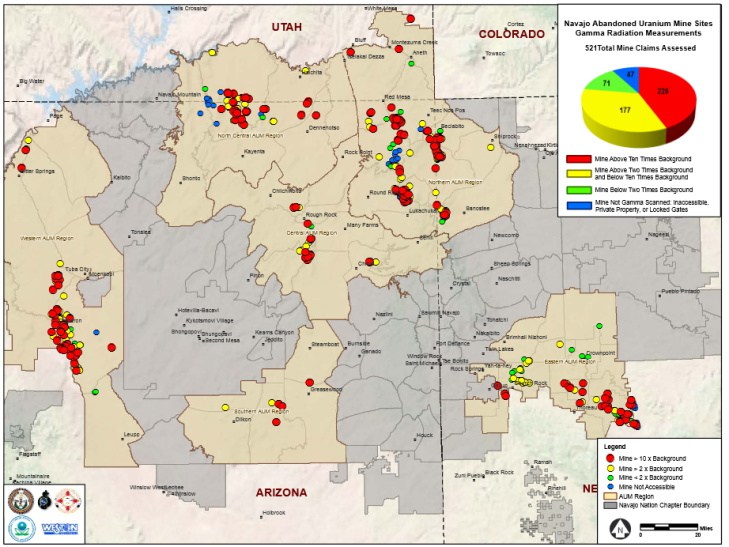
Navajo abandoned uranium mines gamma radiation measurements and priority mines. US EPA
The Los Angeles Times gave us a sense of the risk in 1986. Thomas Payne, an environmental health officer from Indian Health Services, accompanied by a National Park Service ranger, took water samples from 48 sites in Navajo territory. The group of samples showed uranium levels in wells as high as 139 picocuries per liter. Levels In abandoned pits were far more dangerous, sometimes exceeding 4,000 picocuries. The EPA limit for safe drinking water is 20 picocuries per liter.
This unresolved plague of radiation is compounded by pollution from coal mines and a coal-fired power plant that manifests at an even more systemic level; the entire Navajo water supply is currently tainted with industry toxins.
Recent media coverage and spiraling public outrage over the water crisis in Flint, Michigan has completely eclipsed the ongoing environmental justice struggles of the Navajo. Even worse, the media continues to frame the situation in Flint as some sort of isolated incident.
Madeline Stano, attorney for the Center on Race, Poverty & the Environment, assessed the situation for the San Diego Free Press, commenting, “Unfortunately, Flint’s water scandal is a symptom of a much larger disease. It’s far from an isolated incidence, in the history of Michigan itself and in the country writ large.”
Other instances of criminally negligent environmental pollution in the United States include the 50-year legacy of PCB contamination at the Mohawk community of Akwesasne, and the Hanford Nuclear Reservation (HNR) situated in the Yakama Nation’s “front yard.”
While many environmental movements are fighting to establish proper regulation of pollutants at state, federal, and even international levels, these four cases are representative of a pervasive, environmental racism that stacks up against communities like the Navajo and prevents them from receiving equal protection under existing regulations and policies.
Despite the common thread among these cases, the wave of righteous indignation over the ongoing tragedy in Flint has yet to reach the Navajo Nation, the Mohawk community of Akwesasne, the Yakama Nation – or the many other Indigenous communities across the United States that continue to endure various toxic legacies in relative silence.
Current public outcry may be a harbinger, however, of an environmental justice movement ready to galvanize itself towards a higher calling, one that includes all peoples across the United States, and truly shares the ongoing, collective environmental victories with all communities of color.

by Deep Green Resistance News Service | Feb 9, 2016 | Alienation & Mental Health, Colonialism & Conquest
Featured image: A bereaved Guarani family waiting beside a coffin. The wave of suicides that has struck the Guarani Indians in the last 20 years is unequalled in South America. Suicide is often seen as the only option by people forced from their land and into a way of life they did not choose. Photo © João Ripper/Survival
By Survival International
A new report published by Survival International reveals that the appalling suicide rate among the indigenous Guarani Kaiowá people of southern Brazil is the highest in the world.
The rate of self-inflicted deaths within the tribe is 34 times the Brazilian national average, and statistically the highest among any society anywhere on earth. Suicide rates among many other indigenous peoples such as Aboriginal Australians and Native Americans in Alaska also remain exceptionally high. This can be viewed as the inevitable result of the historical and continuing theft of their land and of “development” being forced upon them.
The report, “Progress can Kill,” exposes the devastating consequences of loss of land and autonomy on tribal peoples. As well as the shockingly high suicide rates among tribes, it also reveals high rates of alcoholism, obesity, depression and other health problems.
Particularly striking statistics include the sky-rocketing rates of HIV infection in West Papua, which increased from almost no cases in 2000 to over 10,000 by 2015, and the rate of infant mortality among Aboriginal Australians – twice that in wider Australian society. In large parts of the world, poor nutrition continues to cause further problems, such as malnutrition for Guarani children in Brazil, who are forced to live on roadsides, and obesity for many Native Americans, for whom junk food is the only viable option.
Roy Sesana of the Botswana Bushmen, forcibly evicted from their land in 2002, said: “What kind of development is this when the people lead shorter lives than before? They catch HIV/AIDS. Our children are beaten in school and won’t go. Some become prostitutes. We are not allowed to hunt. They fight because they are bored and get drunk. They are starting to commit suicide. We never saw this before. Is this ‘development?’”

Many Aché starved to death after being forced from their forest home in Paraguay
© Don McCullin/Survival
Olimpio, of the Guajajara tribe in the Brazilian Amazon, said: “We are against the type of development the government is proposing. I think some non-Indians’ idea of ‘progress’ is crazy! They come with these aggressive ideas of progress and impose them on us, human beings, especially on indigenous peoples who are the most oppressed of all. For us, this is not progress at all.”
All of these statistics demonstrate the fatal consequences of forcing change on tribal societies in the name of “progress” and “development.” In many cases, tribes have been forced to move away from abundant and sustainable food sources and a sure source of identity in favour of poverty and marginalization on the fringes of mainstream society. Tragic repercussions of such forced change can continue even several generations down the line.
Around the world, tribes continue to fight for the recognition of their right to live on their lands in peace. Where this right has been respected or restored, tribes flourish. For example after the creation of an indigenous reserve in the northern Amazon in 1992, medical teams worked with tribal shamans and together they halved the mortality rate among the Yanomami Indians. Likewise, the Jarawa In India live on their ancestral lands and enjoy what has been called a “life of opulence.” Nutrionists rate their diet as “optimum.”
For more information you can download Survival’s new short report, “Progress can kill,” and a more in-depth paper for those wanting to know more.
Around the world development is robbing tribal people of their land, self-sufficiency and pride and leaving them with nothing. Watch this short, satirical film, written by Oren Ginzburg and narrated by actor and comedian David Mitchell, which tells the story of how tribal peoples are being destroyed in the name of “development.”
Survival International, the global movement for tribal peoples’ rights, is calling for the United Nations to enforce better protection of tribal land rights and to call on governments to uphold their commitments to their indigenous peoples.
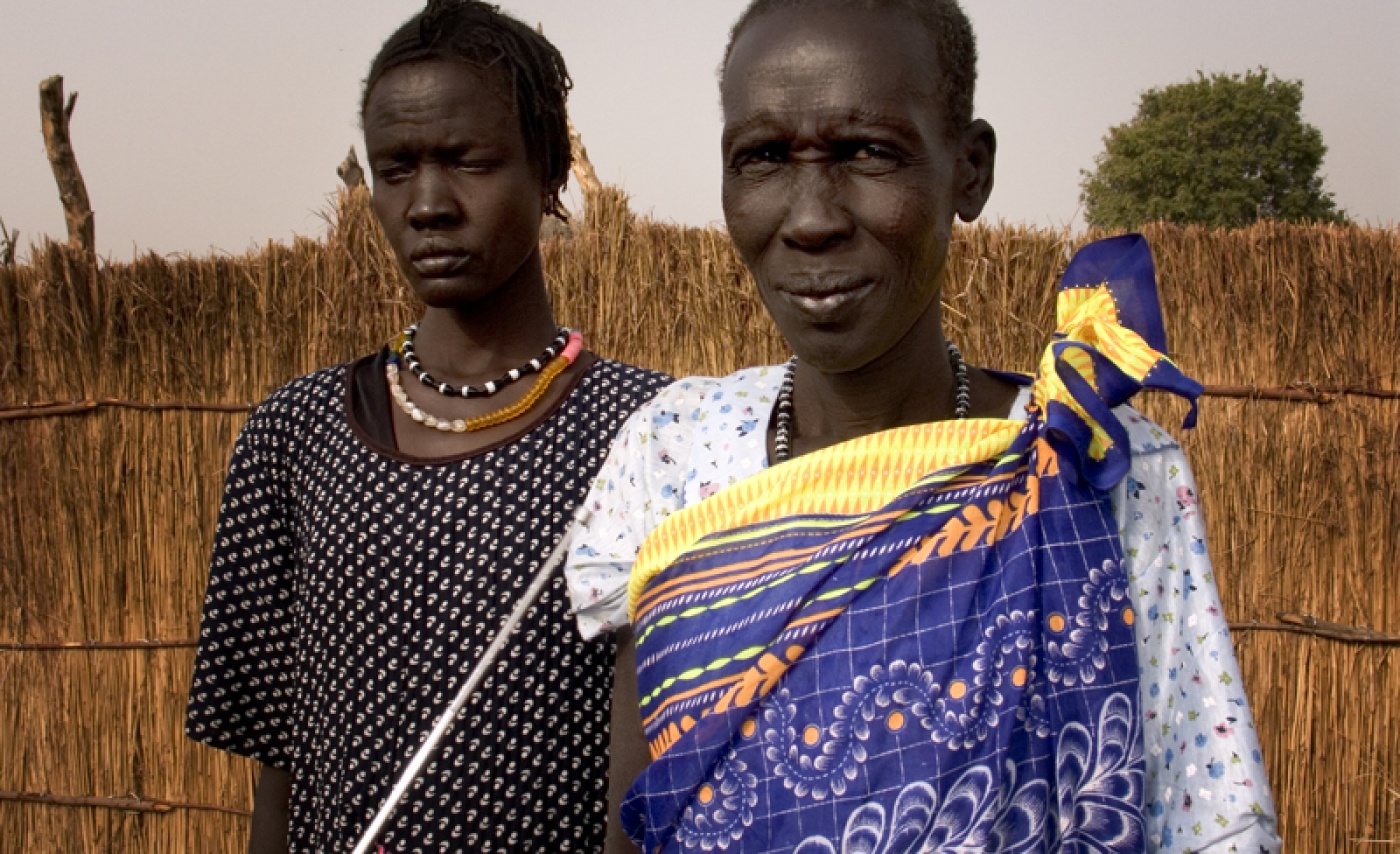
by Deep Green Resistance News Service | Feb 1, 2016 | Agriculture, Colonialism & Conquest
Featured image: Two Anuak women in the Gambella Province of Ethiopia. By Julio Garcia on March 18, 2007.
By Cultural Survival
On December 28, 2015 Ethiopia’s Agricultural Ministry revoked their contract with Karuturi Global Limited, an Indian company who in 2010 won a concession for 100,000 hectares of land to be developed for industrial agriculture for export in the Gambella region of southern Ethiopia, home to the Indigenous Anuak, Mezenger, Nuer, Opo, and Komo peoples. The Agricultural Ministry’s land investment agency cancelled the concession on the grounds that by 2012 Karuturi had developed only 1,200 hectares of land within the initial two year period of the contract.
Since 2013 the company began spiraling out of control, when it was found guilty of tax evasion in in a similar land grab venture in Kenya, and the following year had its operations was taken over by Stanbic Bank.
Karaturi’s Managing Director Sai Ramakrishna has challenged the Agricultural Ministry’s project termination in Ethiopia, telling Bloomberg Business, “I don’t recognize this cancellation,” and is seeking arbitration. If international arbitration is granted, Karuturi will advocate for the continuation of the company’s commercial agriculture plan. Ethiopian officials have dismissed their claims.
Karuturi Global’s project failure resembles that of many foreign investors who have purchased land under the Ethiopian government’s push to lease Indigenous lands to foreign investors, in what many term “land grabbing.” According to Bloomberg, none of these farms in Ethiopia have reported any success in exporting crops.
Ethiopia’s land leasing plans were described as a roadmap to development. Called “villagisation,” the plan involved removing the Indigenous Peoples who sustain themselves from their lands practising farming, hunting, gathering, and pastoralism, and grouping them into established villages, with the idea that the land would be used to produce large scale industrial agriculture to sustain the population’s food needs. Jobs would be created, turning Indigenous Peoples into wage workers who could then buy foods. But Karaturi’s plans were different–aiming to export grains for sale abroad rather than selling them locally, despite Ethiopia’s ban on the export of cereal crops.
The socio-economic transformation promised by the regional government was never realized. Rather, villagisation has meant the forced removal of Indigenous Peoples from their ancestral lands and the creation of an aid-dependant food source. Obang Metho, Anuak human rights activist from Gambella, explained in a video with local media Ethiopian Satellite Television, “This was not empty land. People have been living on this land for generations. When I grew up we didn’t have an office job to earn wages, people depend on land. Our supermarket is going to the field. The field was our bank. When you take away our lands, you are taking away our livelihood, our futures.”

An aerial view of the Dadaab Refugee Camp in Kenya where many Anuak people turned to for shelter after forced removal from Gambella. Photograph taken on November 1, 2011 by Oxfam International
On a morning in late 2010 the Anuak peoples living in the province of Gambella were met by regional government officials and soldiers. Without their knowledge or consent the Ethiopian government had sold an estimated 42% of Anuak land to foreign investors. The Anuak people were forced to leave their only known livelihoods, including essential food sources, and move to government sponsored “villages” which soon turned into refugee camps. In 2012, Human Rights Watch published its report, “’Waiting Here for Death’ Forced Displacement and “Villagization” in Ethiopia’s Gambella Region” documenting the “forcible moving tens of thousands of indigenous people in the western Gambella region from their homes to new villages under a ‘villagization’ program.”
“In their old village there was a school under a mango tree. In the new village, donor money had paid for a new school building. The children, however, were too hungry to attend, roaming instead in the forest looking for food… but now the government can show the world there is a ‘school’” –Anuak refugee displaced to the Dadaab Refugee Camp in Kenya (from The Guardian’s article, Ethiopia’s rights abuses ‘being ignored by US and UK aid agencies’.)
Since their displacement in 2010 the Anuak have become refugees – many having turned to the crowded refugee camps in South Sudan and Kenya. As a result of their forced displacement many of the Anuak, and other Indigenous Peoples of the southwest, have endured scores of human rights violations including documented cases of rape, torture, extrajudicial imprisonment and famine, while these conditions were ignored by donor agencies USAID and DfiD.
Now, Ethiopia, USAID and Dfid have a chance to right their wrongs, and return the lands to the Indigenous Peoples turned into development refugees. But the Agriculture Ministry has said that the rest of the land will return to a “land bank” for future re-investment.
The UN Declaration on the Rights of Indigenous Peoples clearly states in Article 28.1
Indigenous peoples have the right to redress, by means that can include restitution or, when this is not possible, just, fair and equitable compensation, for the lands, territories and resources which they have traditionally owned or otherwise occupied or used, and which have been confiscated, taken, occupied, used or damaged without their free, prior and informed consent.
For the survival of the Indigenous Peoples of Gambella, International aid agencies must take an active role to bring these displaced communities access to lands and a means of sustainable livelihoods.
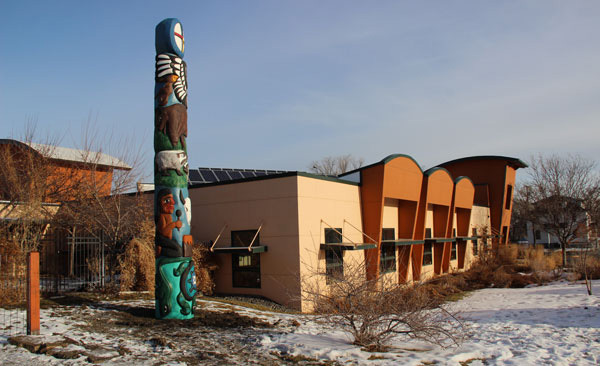
by Deep Green Resistance News Service | Jan 23, 2016 | Colonialism & Conquest
Featured image: The 22-foot western cedar totem pole, which features animals and symbols important to the Northern Cheyenne people was created by Master Carver and Lummi Elder Jewell James and the House of Tears carvers, of the Lummi Nation. The totem pole is a gift from the Lummi Nation to members of the Northern Cheyenne Tribe in southeast Montana as a symbol of solidarity between two tribes whose homelands are threatened by proposed coal export projects. A dedication ceremony for the totem pole was held on January 22, 2016, outside the Northern Plains Resource Council building in Billings, Montana, where the totem pole will stand until a more permanent home is found on the Northern Cheyenne Reservation. Photo courtesy of the Northern Plains Resource Council.
By Sandy Robson / Coal Stop
Author’s note: Today, one hundred and sixty-one years ago, the Treaty of Point Elliott was signed on January 22, 1855, by Isaac Stevens, then-Governor of Washington Territory, and by Duwamish Chief Seattle, Lummi Chief Chow-its-hoot, Snoqualmie Chief Patkanim, and other chiefs, subchiefs, and delegates of tribes, bands, and villages.

Elliott Treaty monument in Mukilteo, WA
In my endeavor to honor today’s 161st anniversary of the signing of the Treaty of Point Elliott, this piece brings attention to the disturbing fact that, presently, certain members of Congress are dishonoring that very same treaty as they seek to undermine it.
Treaty rights of the Lummi people are secured to them by the U.S. federal government in the Treaty of Point Elliott. Specific to treaty fishing rights, is Article 5 of the Treaty provides that, “The right of taking fish from usual and accustomed grounds and stations is further secured to said Indians in common with all citizens of the Territory. . .”
In determining whether Lummi Nation’s treaty-guaranteed rights of access to its usual and accustomed fishing grounds and stations, and harvest of fish, would be adversely impacted by the Gateway Pacific Terminal (GPT) project, a 48 million metric ton per year coal export terminal, the U.S. Army Corps of Engineers (“the Corps”) will be applying a de minimis threshold standard. Any impacts considered to be greater than de minimis by the Corps would warrant the GPT permit denial that Lummi Nation requested of the Corps back over a year ago, on January, 5, 2015.
Underneath the brief summary below of the legislative efforts of several members of Congress, is a detailed outline of the politicians; the campaign money, totaling over a quarter million dollars those politicians have received thus far; and the companies and projects, all relating to legislation that would diminish and undermine tribal treaty rights pertaining to proposed coal export projects in Washington state.
The Story
Congressional legislators who are backed by the coal industry and coal export terminal interests, have tried multiple times to attach a rider onto various bills that would undermine tribal treaty rights relating to the proposed Pacific Northwest coal export terminals. The original amendments proposed were specifically designed to try to prohibit the U.S. Army Corps of Engineers (“the Corps”) from making its determination regarding the Lummi Nation’s treaty fishing rights relating to the proposed Gateway Pacific Terminal at Xwe’chi’eXen (Cherry Point), before the final Environmental Impact Statement (EIS) would be completed for the project.
The language crafted in an amendment presently proposed by federal legislators, could adversely impact the treaty rights of all Indian Tribes and Indian Nations pertaining to projects such as GPT, or the Millennium Bulk Terminal, a 44 million metric ton per year coal export terminal proposed in Longview, Washington, both of which are presently under environmental review.
The fact that the Corps “owes the highest fiduciary duty to protect Indian contract rights as embodied by treaties” is entrenched in case law. That solemn duty and obligation owed to the Lummi Nation by the U.S. federal government, in this case by the Corps in relation to the GPT project, is something the agency addresses separately from any EIS it is tasked with on proposed projects.
In December, 2015, those multiple attempts to attach a rider which would undermine the Lummi Nation’s exercising of its treaty rights relating to the proposed Gateway Pacific Terminal (GPT) project, proved successful when Congressman David McKinley (R-W.Va.), and Congressman Ryan Zinke (R-MT), proposed Amendment 13, the “McKinley Amendment.” The amendment is attached to H.R. 8, the “North American Energy Security and Infrastructure Act of 2015.”
The “McKinley Amendment,” now designated Amendment 850, had originally been designated as Amendment 13 in the House. Amendment 13 was passed by the House on December 2, 2015, and then H.R. 8 was passed by the House the next day, on December 3, 2015.
Amendment 850, the “McKinley Amendment,” seeks to prohibit the denial of a permit for the construction, operation, or maintenance of an export facility until all reviews required under NEPA are complete.
 On December 7, 2015, H.R. 8 was received in the Senate and referred to the Committee on Energy and Natural Resources. The next step for H.R. 8 will be a hearing in the Senate.
On December 7, 2015, H.R. 8 was received in the Senate and referred to the Committee on Energy and Natural Resources. The next step for H.R. 8 will be a hearing in the Senate.
People should contact their U.S. senators to voice their opposition to Amendment 850, the “McKinley Amendment,” that is attached to H.R. 8.
Every day that passes as the Corps is making its decision on the fate of the GPT permit, is another opportunity for coal-backed legislators such as Congressmen McKinley and Zinke, and Senator Daines, to craft legislation aimed at diminishing Lummi Nation’s, and other tribes’ treaty rights.
Honor The Treaty. Now.
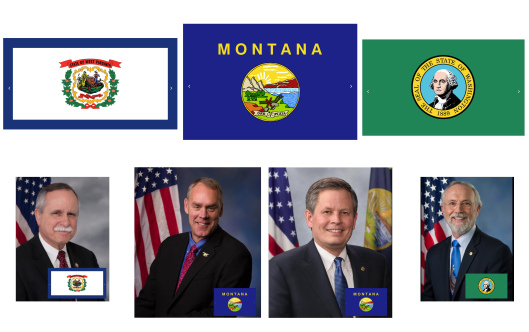
Top row, left to right: state flags of West Virginia, Montana, and Washington State. Bottom row, left to right: Congressman David McKinley (R-W.Va.), Congressman Ryan Zinke (R-MT), U.S. Senator Steve Daines (R-MT), Congressman Dan Newhouse (R-WA).
The Politicians
Congressman Ryan Zinke (R-MT) — Ryan Zinke, along with U.S. Senator Steve Daines, led a group of sixteen senators and seventeen members of the House in sending two July 28, 2015 letters (one from the Senate and one from the House) to the U.S. Army Corps of Engineers. The letters urged U.S. Assistant Secretary of the Army Jo-Ellen Darcy, to complete the environmental review process for the proposed GPT project prior to the Corps making a determination whether impacts to any tribes’ U&A (usual and accustomed) treaty fishing rights are more than de minimis, or too small or trivial to warrant legal review.
U.S. Senator Steve Daines (R-MT) — Senator Daines attempted multiple times, during the summer of 2015, to attach a specifically crafted amendment to various pieces of unrelated legislation. The amendments were specifically designed to try to prohibit the Corps from making its determination regarding the Lummi Nation’s treaty fishing rights relating to the proposed GPT, before the final Environmental Impact Statement (EIS) would be completed for the project. Daines ended up withdrawing his amendment. It is important to note that while Senator Daines orchestrates such efforts against the treaty rights of the Lummi Nation, he is a member of the Senate Committee on Indian Affairs.
Senator Daines, along with Congressman Zinke, led the group of sixteen senators and seventeen members of the House in sending the two July 28, 2015 letters mentioned above, to the U.S. Army Corps of Engineers.
Congressman David McKinley (R-W.Va.)— McKinley proposed Amendment 13 (now designated Amendment 850), the McKinley Amendment, which the House passed by a voice vote on December 2, 2015. Congressman Zinke co-sponsored that amendment.
Congressman Dan Newhouse (R-WA) – Dan Newhouse’s office was contacted about his position on Amendment 13 (now called Amendment 850) that was passed by the House on December 2, 2015, by a voice vote. Congressman Newhouse’s office staff responded “he supports that amendment, he supported it in the Rules Committee, and worked with McKinley and Daines on that.” Apparently, once again, Senator Daines has been involved in an attempt to undermine the treaty rights of the Lummi Nation, as he worked with Congressman McKinley on Amendment 850.
The Money
Congressman David McKinley (R-W.Va.), so far, has received the following campaign contributions relating to the proposed coal export terminals:
–$1,000 from FRS Capital for 2015-2016
–$3,500 from Arch Coal for 2015-2016
–$2,000 National Mining Association for 2015-2016
–$10,750 from Arch Coal for 2013-2014
–$5,000 from National Mining Association for 2013-2014
–$33,500 from Arch Coal for 2011-2012
–$10,000 from National Mining Association for 2011-2012
–$2,400 from Boich Companies for 2012 election cycle
Congressman Ryan Zinke (R-MT), so far, has received the following campaign contribution for the 2015-2016 election cycle relating to the proposed coal export terminals:
–$6,000 from FRS Capital Corp (ultimate parent company over Carrix and SSA Marine) for 2015-2016 election cycle
–$4,500 from Cloud Peak Energy (has 49% stake in PIT/GPT) for 2015-2016 election cycle
–$4,000 from Arch Coal for 2015-2016 election cycle
–$3,000 from National Mining Association for the 2015-2016 election cycle
–$17,700 from BNSF/Berkshire Hathaway for 2013-2016
Senator Steve Daines (R-MT), so far, has received the following campaign contributions relating to the proposed coal export terminals:
–$2,500 from FRS Capital Corp for the 2015-2016 election cycle
–$32,500 from Berkshire Hathaway for 2013-2016
–$26,400 from Boich Companies for 2013-2016
–$16,000 from Cloud Peak Energy for 2015-2016
–$11,500 from Arch Coal for 2013-2016
–$17,500 from National Mining Association for 2013-2016
Congressman Dan Newhouse (R-WA), so far, has received the following campaign contributions relating to the proposed coal export terminals:
–$6,000 from FRS Capital Corp (ultimate parent company over Carrix and SSA Marine) for the 2014 election cycle
–$2,500 from FRS Capital Corp/SSA Marine for the 2015-2016 election cycle
–$6,000 from Berkshire Hathaway (parent company over BNSF which would transport coal from WY and MT to the proposed Pac NW coal export terminals) for 2015-2016 election cycle
–$3,000 from Arch Coal for 2015-2016 election cycle
–$1,000 from National Mining Association for 2015-2016 election cycle
All of the campaign contributions listed above were obtained from the website, OpenSecrets.org.
The Companies and Proposed Projects
Gateway Pacific Terminal (GPT) — a proposed 48 million ton per coal export terminal at Cherry Point, in Whatcom County, Washington
Pacific International Terminals (PIT) — a subsidiary of SSA Marine and the applicant for the GPT project
SSA Marine — parent company over PIT
FRS Capital Corp — parent company over Carrix. Carrix is the parent company over SSA Marine
Cloud Peak Energy — presently has a 49% interest in PIT/GPT, and has an agreement with SSA Marine for an option to ship up to 17.6 million short tons of capacity per year through GPT
Arch Coal — in January, 2011, Arch Coal acquired a 38% equity interest in Millennium Bulk Terminals-Longview, LLC and its proposed Millennium Bulk Logistics Terminal. Arch Coal filed for Chapter 11 bankruptcy on January 11, 2016. Since Arch Coal filed for Chapter 11 bankruptcy, the stock has lost more than 80% of its value, and effective January 12, 2016, trading in Arch Coal common stock was suspended on the New York Stock Exchange
Millennium Bulk Terminals-Longview Coal Export Terminal — a proposed coal export terminal project to redevelop an operating bulk materials port on the Columbia River in Longview, Washington, for the export of 44 million metric tons of coal annually. The terminal is served by BNSF and Union Pacific railroads
Millennium Bulk Terminals-Longview, LLC (formerly Millennium Bulk Logistics) — a subsidiary of Australia-based Ambre Energy that was a majority (62%) partner in the Millennium Bulk Logistics Longview Terminal project (Arch Coal has a 38% interest). In November 2014, Ambre Energy sold its two Rocky Mountain coal mines and its stake in proposed coal export terminals planned for Washington and Oregon to Resource Capital Funds (a Denver, Colorado private equity firm) for $18 million, according to company filings with Australian regulators
Resource Capital Funds (RCF) is a long-established investor in Ambre Energy, maintaining a voting position on the company’s board, and loaning Ambre approximately $95 million. RCF bought the Decker mine in Montana, and the Black Butte mine in Wyoming, along with Ambre’s stake in the Morrow Pacific Project in Oregon and its stake in Millennium Bulk Logistics Longview Terminal in Washington
Ambre Energy had purchased Cloud Peak Energy’s 50% interest in Decker mine and related assets in September of 2014, and assumed 100% ownership of Decker Mine. Part of that deal included an option granted to Cloud Peak Energy for up to 7 million metric tonnes per year of throughput capacity at the proposed Millennium Bulk Logistics Longview Terminal, and Ambre Energy’s assumption of all reclamation and other Decker liabilities and replacement of Cloud Peak Energy’s $66.7 million in outstanding reclamation and lease bonds
Under the deal between RCF and Ambre Energy, RCF would operate under the name Ambre Energy North America, and the leadership team would stay the same. In April 2015, Ambre Energy North America changed its name to Lighthouse Resources Inc. Lighthouse Resources is a privately held company headquartered in Salt Lake City, Utah
BNSF Railway — applicant for the interrelated (to GPT) Custer Spur rail project and company that would transport coal from WY and MT to the proposed GPT and Millennium Bulk coal export terminals
Berkshire Hathaway — parent company over BNSF
Boich Companies — Boich Companies is a privately held coal mining and marketing company headquartered in Ohio, and is a joint-owner of Signal Peak Energy, LLC (Signal Peak Coal Mine) in Montana. Signal Peak Energy is jointly-owned by Boich Companies, FirstEnergy Corp., an Ohio-based utility company, and Pinesdale LLC, a wholly-owned subsidiary of Swiss commodity trader Gunvor Group, Ltd. The three partner companies formed an entity, Global Mining Holding Company LLC, to hold all the ownership interests. Global Mining Holding Company’s owners are FirstEnergy Ventures, a subsidiary of FirstEnergy; WMB Marketing, a Boich subsidiary; and Gunvor Group
Signal Peak Energy is a major exporter of coal, primarily to Asia, so it’s likely that Boich Companies is interested in getting a contract for shipping/exporting its Signal Peak coal to Asia through GPT in Whatcom County, WA. It is currently shipping coal through Westport Terminal in British Columbia. Signal Peak Energy is jointly-owned by Boich Companies, FirstEnergy Ventures (Ohio-based utility company), and Pinesdale LLC, a wholly-owned subsidiary of Swiss commodity trader Gunvor Group, Ltd.
Boich Companies is part owner Global Coal Sales Group which acquires coal mined at its affiliate Signal Peak Energy’s mine, from FirstEnergy Generation (a subsidiary of FirstEnergy Corp), and sells the coal in the international market. Global Coal Sales Group LLC, contributed $50,000 to the coal interest-funded Political Action Committee SaveWhatcom, during the 2013 Whatcom County election
National Mining Association (NMA) — is the national trade organization of the U.S. mining industry representing mining interests before Congress, the Administration, federal agencies, the judiciary, media, and the public. NMA also has at least two Political Action Committees.
Cloud Peak Energy, BNSF Railway, Peabody Energy, Millennium Bulk Terminals, Arch Coal, and Lighthouse Resources are listed members of the National Mining Association
Goldman Sachs — it was announced on July 5, 2007, that Goldman Sachs Infrastructure Partners committed to equity investment in Carrix (parent company over SSA Marine), giving Goldman Sachs Infrastructure Partners a 49% interest in Carrix). This funding was integral to the Gateway Pacific Terminal project. In January 2014, Goldman Sachs pulled out of the GPT project, selling its 49% interest back to SSA Marine.










